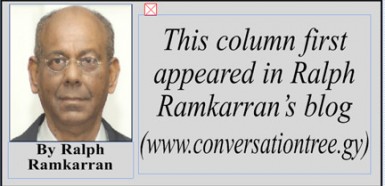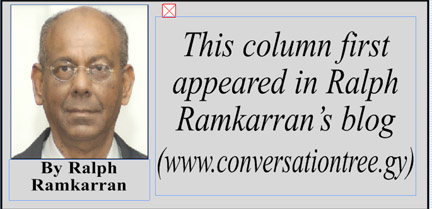 The government is silently leaning the economy towards Burnham’s socialist control system, to cooperativism and poverty, where the sugar workers suffer and the private sector has no influence. The past government’s policies favoured drug lords, the criminally inclined and business crooks. While these two parties are in existence racism will never die in Guyana and the problems outlined above, and more, will never be resolved. Guyanese have a decision to make, or not to make and to live with the consequences. That decision is whether or not to support a political party for the next elections to be soon announced by Mr Craig Sylvester, whose views, as set out in a letter in yesterday’s KN, are summarized above.
The government is silently leaning the economy towards Burnham’s socialist control system, to cooperativism and poverty, where the sugar workers suffer and the private sector has no influence. The past government’s policies favoured drug lords, the criminally inclined and business crooks. While these two parties are in existence racism will never die in Guyana and the problems outlined above, and more, will never be resolved. Guyanese have a decision to make, or not to make and to live with the consequences. That decision is whether or not to support a political party for the next elections to be soon announced by Mr Craig Sylvester, whose views, as set out in a letter in yesterday’s KN, are summarized above.
The dominant narratives in and about Guyana are conditioned by slavery, indentureship and their consequences. One major consequence is the existence of two ethnic blocs which have been socialized differently and separately. Guyana consists largely of two different societies, in watchful competition, but largely at peace, existing under the same national roof.
The manner in which these ethnic blocs represent what they perceive their interests to be has evolved over the years, but with a central theme revolving around the idea of agreed united political action. During the 1950s, two major industrial events, namely the Teare strike of transport workers and the Enmore strike of sugar workers pushed the restive middle class into a national alliance under the PPP. The underlying idea was that cooperation to achieve independence and socialism will benefit all who were represented under the big tent of the PPP. That idea of a single big, political tent did not last and it should be no surprise that it did not.
Political parties represent interests, initially as Marx identified, class interests. The rise in consciousness of ethnic groups have resulted in political parties as ethnic instruments. No political party in Guyana will admit this. One reason is that they also receive substantial support from other groups for varying reasons, although more than ninety per cent of the major ethnic groups support their favoured party. For the foreseeable future, therefore, there will be two major political parties in Guyana, largely representing the two major ethnic groups. These parties might not necessarily be the PPP and the PNC but we should be thankful that it is these two parties and not other, more extreme, fascistic parties. We have had a difficult and unfortunate history, but it could have been worse.
In earlier decades, it was frowned upon – infra dig ‒ for ethnic groups to represent that they had separate interests that were independent of the national interest. This has changed for many reasons, both external and internal, as the decades went by. It is now argued that ethnic interests are part of or in the national interest. The reasons are important but an analysis is beyond the scope of this article. What is important to acknowledge is that independent organizing and articulation of such interests are being accommodated, resentfully or grudgingly sometimes, but accepted.
While the ideal of political unity under one party did not survive, the idea of united political action survived the rise of ethnicity. This is one of Guyana’s enduring political narratives. The split in the PPP occurred in 1955. By the early 1960s there was serious talk and negotiation for a coalition government to ease the political tension at that time. In the mid-1970s, the PPP proposed a coalition arrangement under the national patriotic front government. In the 1990s the PPP adopted the principle of ‘winner does not take all.’ In 2002 the PNC accepted ‘shared governance’ in principle. In 2015 the APNU+AFC coalition accepted constitutional reform which will see: 1. separate elections for president; 2. the vice-president being the person who receives the second highest votes in the presidential elections; 3. all political parties gaining more than 15 per cent of the vote being part of the government. The coalition promised to start the process of constitutional reform within one month of its election to office.
The bleakness of Mr Sylvester’s prognosis is shared by many. But his solution, another political party, will not solve the problem. Third parties or movements worldwide have a short life unless they represent a stable and permanent minority interest. They have not survived in Guyana and appeals to racial unity will continue to fall on deaf ears. Africans and Indians want to support the parties which they perceive are representing them.
We need to accept the existence of the PPP and PNC and work to being united politically by way of constitutional reform which both political parties and the diplomatic community in Guyana support. This will not solve all problems but it is the basic pre-requisite for the reduction of discrimination, corruption and the other ills mentioned by Mr Sylvester. With the developing oil economy and vastly more resources available, these problems will intensify and multiply unless there is a political solution in Guyana. Corruption did not emerge with the PPP. One reason that caused its expansion was the expansion of public spending from $3 billion a year prior to 1992 to $20 billion plus thereafter. With the oil resources, which will multiply public spending several times over, and one political group in control, imagine what will happen!





